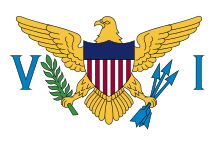VIRGIN ISLANDS OF THE UNITED STATES
 This archipelago in the Lesser Antilles, situated at 64 km east of Puerto Rico, belongs to the United States. It is composed of 60 islets and islands among them St Thomas, St John and St Croix. Its whole area is 352 sq km.
This archipelago in the Lesser Antilles, situated at 64 km east of Puerto Rico, belongs to the United States. It is composed of 60 islets and islands among them St Thomas, St John and St Croix. Its whole area is 352 sq km.
The largest island is Saint Croix which is located in 64 km south of the other Virgin Islands. Because of its fertile coastal plains where grew sugar cane, the island is nicknamed “Garden of the Antilles”. The mountains erect in the centre of the island.
Saint Thomas is the second island by its area (83 sq km). The United States Virgin Islands’ capital – Charlotte Amalie – is settled in the south coast. The north-west coast has several beautiful beaches. In the Marine Park at Coki Point (1,8 ha), it is possible to see sharks, turtles or mangrove swamps…
Saint John is located in 5 km east of St Thomas. The green nature is everywhere. 75% of the island belongs to the Virgin Islands National Park (3845 ha). In the early 1950s, the American millionaire, Laurence Rockefeller, stayed in the island, built the station Cancel Bay and gave over 2000 ha to the US government. In 1956, this land became the Virgin Islands of the United States National Park. During the following years, almost 4000 ha were added to the reserve by the government. The park is home for more than 30 species of bird, iguanas, geckos, turtles and is composed of a tropical rainforest, a dry forest, archeologist sites, beaches…
In these volcanic islands with humid mountains in the centre, caostal dry vegetation and coastal plains a lot of animals were introduced : pigs, wild horses, donkeys, goats, no-poisonous snakes including the Virgin Islands tree boa. There are also more than 200 species of bird among them the bananaquit, the national bird.
The economic activities are tourism, fishing and farming. In St Croix, there is an oil refenery (the oil comes from Venezuela) which employs 6 000 people. It is the World’s 5th largest refinery (Hovensa Oil Refinery).
Christopher Columbus discovered these islands in 1493, during his second voyage in the New World. He named them Santa Ursula and The 11 000 Virgines (Santa Ursula y Las Once mil Virgenes). About 2000 BC, the Ciboneys already lived in this land. The Tainos took their place, then, the Caribs exterminated them. Until the Spanish Armada’s defeat in 1588 by the English, the Spaniards dominated the archipelago.
Holland, France y Great Britain tried to claim these islands. They became bases for pirates.
In the end, in the 18th century, the English settled in the islands situated east of St John, especially in Tortola island. The Danes colonized St Thomas that became a free port in 1724. The European settlers grew sugar cane and tabacco thanks to the trade of thousands of African slaves. Denmark bought St Croix to France, in 1733. The bad treatments caused slaves’ revolts in the archipelago, in particular in St Croix where in 1848, slavery was abolished. The colonists continued exploiting the Black workers so others revolts broke out and the plantations fell in ruins. Moreover, Europe started to produce beetroot sugar.
In 1867, USA wanted to buy the Danish Virgin Islands but the American Congress refused to pay 7,5 million dollars. During the First World War, the Americans paid 25 million dollars to Denmark because they feared that the Germans invade these Caribbean islands. If, in 1931, US president Herbert Hoover regreted the purchase of the Virgin Islands during his stay in the archipelago, US president Theodore Roosevelt saw its potential when he visited it, in 1934, so he developed them.
After the Cuban Revolution, the American tourists went en masse to the Virgin Islands of the United States that had built infrastructure.
Area : 352 sq km (136 sq miles)
Population : 104 900 inhabitants
Capital : Charlotte Amalie (St Thomas Island)
Language : English
Currency : US Dollar (US$)
People : US Virgin Islanders
